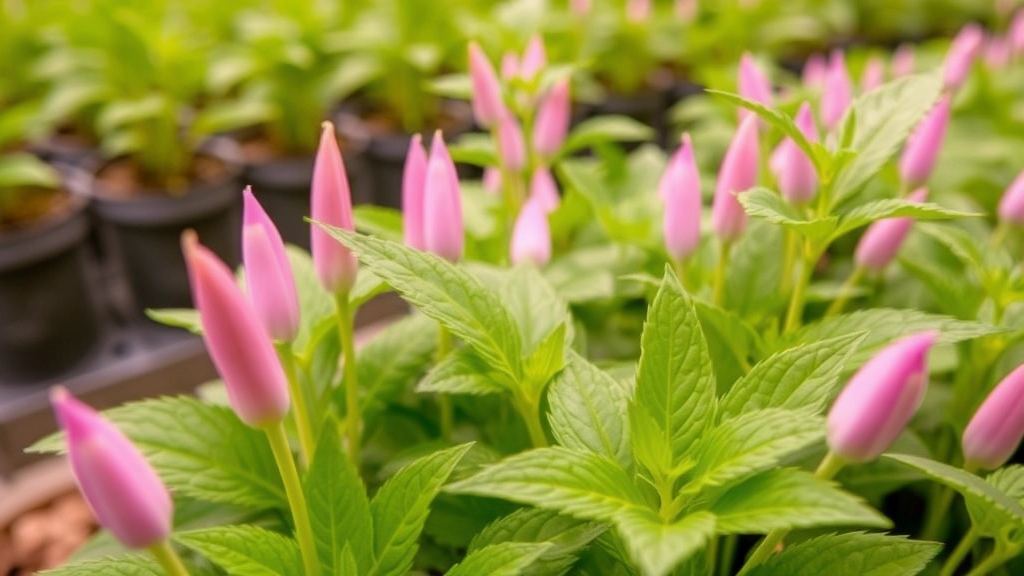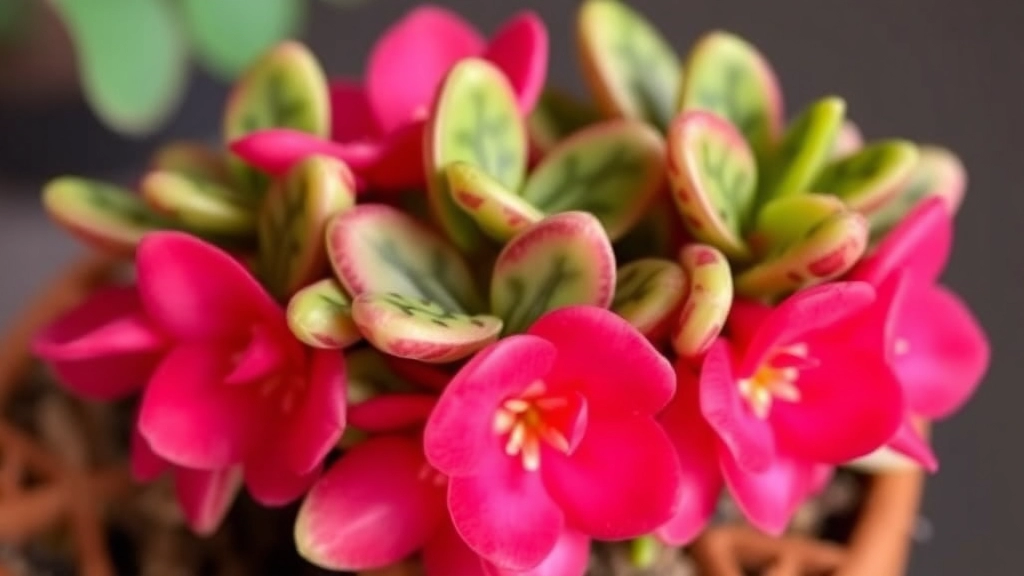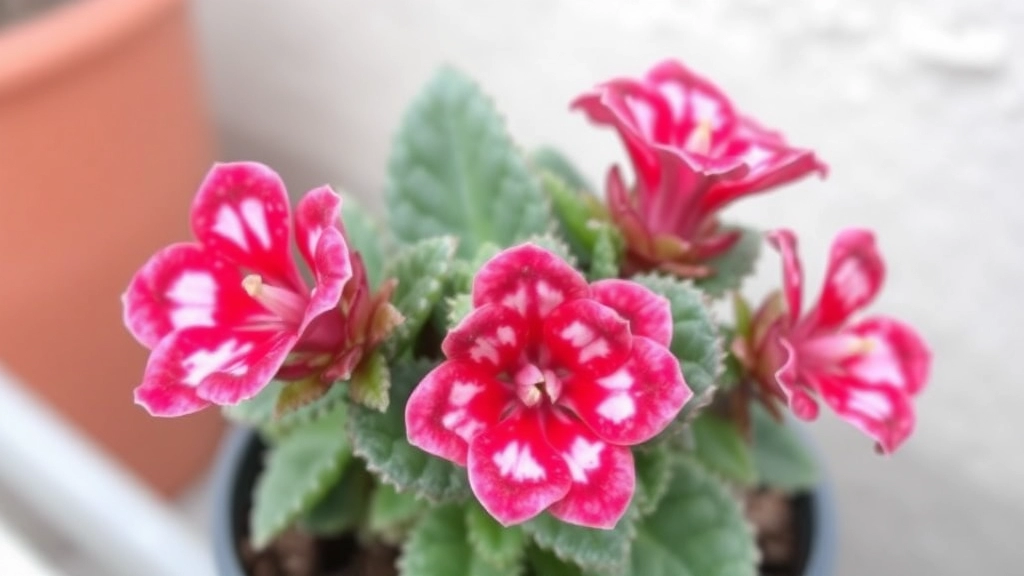Kalanchoe Marmorata: The Penwiper Plant
The Kalanchoe Marmorata, also known as the Penwiper Plant, is a striking succulent that stands out with its marbled, white and green leaves. If you’re looking to add this unique plant to your collection, understanding its care needs is essential. This guide will walk you through the key features, ideal growing conditions, and tips for successful propagation.
Care Needs
To keep your Kalanchoe Marmorata thriving, it’s crucial to provide the right balance of light, water, and soil. This succulent prefers bright, indirect sunlight and well-draining soil to prevent root rot. Watering should be done sparingly, allowing the soil to dry out completely between waterings. With these simple steps, you can ensure your Penwiper Plant remains healthy and vibrant.
When considering which plants to incorporate into your collection, one may wonder about the unique characteristics of Kalanchoe Marmorata, commonly known as the Penwiper Plant.
This charming succulent is not only visually appealing but also boasts several distinctive features that make it a favourite among plant enthusiasts.
### Distinctive Leaf Structure
– **Shape**: The leaves of Kalanchoe Marmorata are thick, fleshy, and often have a wavy or scalloped edge.
– **Colour**: They exhibit a stunning green hue, often with mottled patterns that can range from light to dark shades.
– **Size**: Leaves can grow up to 15 cm long, making them a striking feature in any setting.
### Unique Flowering
– **Blooms**: This plant produces clusters of small, tubular flowers that can be pink, red, or orange, adding a vibrant splash of colour.
– **Season**: Typically blooms in late winter to early spring, providing a delightful contrast to the otherwise dormant garden.
### Growth Habit
– **Height**: Kalanchoe Marmorata can reach heights of up to 1 metre, making it an eye-catching addition to both indoor and outdoor spaces.
– **Form**: The plant has a bushy, upright growth habit, which allows it to fill space effectively while adding texture.
For those interested in expanding their Kalanchoe collection, understanding the [different types of Kalanchoe plants](https://planthq.org/discover-the-different-types-of-kalanchoe-plants-2/) can provide valuable insights. Additionally, if you’re looking to propagate this or other Kalanchoe varieties, our [step-by-step guide to Kalanchoe propagation from leaves](https://planthq.org/stepbystep-guide-kalanchoe-propagation-from-leaves/) can be a helpful resource.
Ideal Growing Conditions for the Penwiper Plant

So, you’re keen on nurturing your Kalanchoe Marmorata, or as it’s affectionately known, the Penwiper Plant? You’re not alone in wanting a thriving, vibrant plant that adds character to your space. Let’s dive into the ideal growing conditions to ensure your Penwiper Plant flourishes.
Light Requirements
- Bright, Indirect Light: Kalanchoe Marmorata loves bright light but can’t handle direct sunlight.
- East or West Windows: Place it near these windows for optimal growth.
Temperature and Humidity
- Warm Temperatures: Ideally, keep your plant in temperatures between 18-24°C (65-75°F).
- Low Humidity: This plant prefers drier air, so avoid overly humid environments.
Soil Type
- Well-Draining Soil: Use a cactus or succulent mix.
- pH Levels: Aim for a slightly acidic to neutral pH (around 6.0-7.0).
Potting and Drainage
- Good Drainage: Ensure your pot has drainage holes to prevent waterlogging.
- Terracotta Pots: These are great as they allow for air circulation and help with moisture control.
Air Circulation
- Breezy Spots: A little air movement is beneficial. Avoid cramped spaces to prevent fungal issues.
How to Water and Fertilize Kalanchoe Marmorata
Caring for Kalanchoe Marmorata, also known as the Penwiper Plant, involves understanding its specific watering and fertilizing needs. Many plant enthusiasts often wonder how they can keep their plants thriving without overdoing it.
Propagation Methods for Kalanchoe Marmorata

If you’re looking to expand your collection of Kalanchoe Marmorata, you’re in luck! Propagating this stunning plant is both straightforward and rewarding. Many enthusiasts often wonder about the best ways to propagate their Penwiper Plant effectively.
1. Leaf Cuttings
One of the most popular methods for propagating Kalanchoe Marmorata is through leaf cuttings. Here’s how to do it:
- Select a Healthy Leaf: Choose a mature, healthy leaf from the parent plant.
- Cut the Leaf: Use a clean, sharp knife to cut the leaf at the base.
- Dry the Cutting: Allow the cutting to dry for a few hours to form a callus over the cut surface.
- Plant the Cutting: Place the callused end into well-draining soil, burying it about an inch deep.
- Water Sparingly: Water lightly until roots develop, usually within a few weeks.
2. Offsets
Kalanchoe Marmorata often produces offsets, which are small plants that grow at the base of the parent. Here’s how to propagate using offsets:
- Identify Offsets: Look for small plants growing near the base of the parent.
- Remove Offsets: Gently twist or cut the offset away from the parent plant, ensuring some roots are attached.
- Re-pot: Place the offset in its own pot with well-draining soil.
- Water: Water lightly and allow it to establish.
3. Seed Propagation
Although less common, you can also propagate Kalanchoe Marmorata from seeds. Here’s a simple guide:
- Gather Seeds: Collect seeds from mature flowers when they dry out.
- Prepare Soil: Use a seed-starting mix that drains well.
- Sow Seeds: Scatter the seeds on the surface and lightly press them into the soil.
- Water: Mist the soil to keep it moist but not soggy.
- Provide Light: Place the pot in a bright location but avoid direct sunlight until seedlings emerge.
When caring for your Kalanchoe Marmorata, also known as the Penwiper Plant, you might encounter a few challenges. Understanding these common problems and their solutions can ensure your plant thrives.
### 1. Overwatering
**Symptoms**: Yellowing leaves, mushy stems, and root rot.
**Solution**:
– Allow the soil to dry out completely between waterings.
– Ensure your pot has drainage holes.
– If root rot occurs, trim away affected roots and repot in fresh soil. For more detailed advice, check out [how to fix drooping Kalanchoe leaves](https://planthq.org/how-to-fix-drooping-kalanchoe-leaves-causes-and-solutions/).
### 2. Underwatering
**Symptoms**: Wrinkled leaves and drooping.
**Solution**:
– Water thoroughly when the top inch of soil feels dry.
– Consider a consistent watering schedule, especially during the growing season.
### 3. Pests
**Symptoms**: Sticky residue, webbing, or visible insects on leaves.
**Solution**:
– Regularly inspect your plant for pests like aphids or mealybugs.
– Use insecticidal soap or neem oil to treat infestations.
– Keep the plant clean by wiping leaves with a damp cloth.
### 4. Poor Light Conditions
**Symptoms**: Stretched growth or leaf drop.
**Solution**:
– Position your Penwiper Plant in bright, indirect sunlight.
– If indoors, consider placing it near a south-facing window. Learn more about [how to grow Kalanchoe from leaves](https://planthq.org/how-to-grow-kalanchoe-from-leaves-easy-guide/).
### 5. Nutrient Deficiency
**Symptoms**: Pale leaves or stunted growth.
**Solution**:
– Fertilize with a balanced, water-soluble fertilizer during the growing season.
– Follow the package instructions for dilution and frequency.
How to Display and Use Kalanchoe Marmorata in Your Garden or Indoors
So, you’ve got your Kalanchoe Marmorata, also known as the Penwiper Plant, thriving beautifully. Now, how do you show it off?
Choosing the Right Spot
First things first, think about where you want to place your plant.
- Indoors: A bright windowsill is perfect. Kalanchoe loves light but can also handle some indirect sunlight.
- Outdoors: If you’re in a milder climate, consider placing it on a patio or balcony. Just ensure it’s protected from harsh winds.
Creating a Stunning Display
Let’s talk aesthetics. Kalanchoe Marmorata has those unique, spotted leaves that can really stand out.
- Group Planting: Pair it with other succulents for a vibrant display. Think of contrasting colours and textures.
- Containers: Use decorative pots that complement your home or garden style. Terracotta or ceramic pots can add a rustic charm.
Using Kalanchoe Marmorata in Your Space
Beyond just looking good, this plant can also serve practical purposes.
- Air Purification: It helps clean the air, making it a great addition to your living room or office.
- Natural Decor: It can be a focal point on a dining table or a stylish addition to your desk.
Caring for Your Display
Keeping your Kalanchoe looking fresh is key.
- Dusting: Wipe the leaves occasionally to keep them clean and vibrant.
- Rotation: Turn the pot every few weeks to ensure even growth.
For more detailed care tips, check out our ultimate guide to growing Kalanchoe and our flowering Kalanchoe care tips.
FAQs about Kalanchoe Marmorata (Penwiper Plant)
What are the light requirements for the Penwiper Plant?
The Kalanchoe Marmorata thrives in bright, indirect light. It is best to place it near east or west windows for optimal growth.
What is the ideal temperature and humidity for Kalanchoe Marmorata?
This plant prefers warm temperatures between 18-24°C (65-75°F) and low humidity. Avoid overly humid environments to keep it healthy.
What type of soil is best for the Penwiper Plant?
Use a well-draining soil, such as a cactus or succulent mix. Aim for a soil pH that is slightly acidic to neutral, around 6.0-7.0.
What kind of pot is best for Kalanchoe Marmorata?
Terracotta pots are ideal as they allow for air circulation and help with moisture control. Ensure the pot has drainage holes to prevent waterlogging.
How can I propagate Kalanchoe Marmorata?
You can propagate the Penwiper Plant through leaf cuttings, offsets, or seeds. Each method has its own steps and requirements for successful propagation.
How do I propagate using leaf cuttings?
Select a healthy leaf, cut it at the base, let it dry to form a callus, and then plant it in well-draining soil. Water sparingly until roots develop.
How do I propagate using offsets?
Identify small plants growing at the base of the parent, gently remove them ensuring some roots are attached, and re-pot them in well-draining soil. Water lightly and allow them to establish.
How do I propagate using seeds?
Collect seeds from mature flowers, prepare a seed-starting mix, sow the seeds on the surface, mist the soil to keep it moist, and place the pot in a bright location avoiding direct sunlight until seedlings emerge.
What are the benefits of air circulation for the Penwiper Plant?
A little air movement is beneficial for Kalanchoe Marmorata. Placing it in breezy spots helps prevent fungal issues and promotes overall plant health.
References
-
Growing and Caring for Kalanchoe Marmorata
-
How to Grow Kalanchoe Marmorata
-
Kalanchoe Marmorata: Care and Propagation Guide
